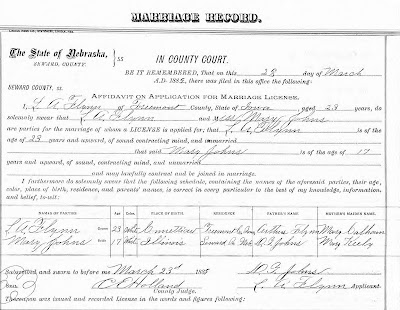 |
| Arthur and Mary Flynn, together with their children: Lester, Nellie, Sadie and William. ca. 1910. |
Yet, my great-great-great grandparents Arthur Flynn and Mary Clarissa Calhoun were married on Valentine's Day, 1865. The end of the Civil War which had gripped the nation for four long years was still several months away. It was winter – in between harvest and planting – a season when many farmers found time to marry. It was a Tuesday. So, why get married on that particular day? Maybe it was due to a touch of romance!
Mary was the oldest of ten children in a family with deep New England roots in Connecticut. Arthur had emigrated from Ireland less than a decade earlier. Their romance already seemed a bit improbable. Although the newspaper notice above from the Hartford Daily Courant (Friday, February 17, 1865, pg 2) provides scant information, a few more details about their wedding can be found in a volume of reminiscences, Litchfield County Sketches, by Rev. Newell Meeker Calhoun. Newell was Mary's brother and his book provides many insights into their family life. It was hard work, but it wasn't all work, as I discovered.
 |
| Adele Anais Toudouze. Wedding fashion, 1865. |
In that state parlor, Newell writes, "were a funeral and a wedding, when a son went away to the home prepared for him and a daughter to make one for herself." The funeral was that of younger brother, Willie, who died in 1863 of encephalitis, just a month shy of his 7th birthday. The wedding was Mary and Arthur's. Although no picture of their wedding day survives, the photograph above of Arthur and Mary and their four children is a testament to their enduring marriage. Mary died in Nebraska, at the home of her daughter Nellie, after a long illness in 1910. Arthur lived until 1921. They are buried together at Rose Hill Cemetery in Shenandoah, Iowa, where they moved after their marriage.
I'd love to think that they both had a little bit of poetry in their soul and their choice of wedding date was very deliberate, indeed! Happy Valentine's Day! And happy anniversary to Mary and Arthur, married 153 years ago, today.


















